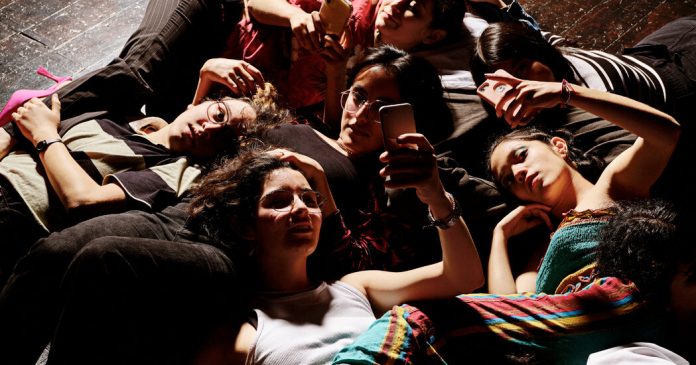But you can use the first few paragraphs of each essay — what appears before the first photos — as mentor texts for your own introductions, and we’ll show you how, below.
First though, let’s remember your broader goals. As we wrote at the top of this post, together, your introduction, photo essay and captions should answer these questions:
What is this community?
Who is in it?
Where and when does it meet?
How did the community come to be? How does it operate?
Why does it matter to its participants? Why should it matter to viewers?
Take a look at “In This Nigerian Market, Young Women Find a Place of Their Own” as an example. Here is the introduction, the first 200 or so words before the photo essay begins to scroll:
At the bustling Yaba Market in Lagos, Nigeria, there is something for everyone.
Chatter rises from the traders, whose stalls sprawl over miles of cracked gray concrete and packed earth. They might be selling baskets of fresh fruit, wheelbarrows stuffed with phone cases, piles of sequined fabrics or racks of second-hand clothes.
If you’re lucky, you might find a vintage jacket you’ve been searching for, or a pair of long-lasting Levi’s jeans. But you’re never going to be as lucky as Dencity: the coolest of the cool kids of Lagos. These skaters, often clad in a uniform of baggy pants and crop tops, head to the market to go thrifting each week. They’re armed with fashion knowledge only the young, fun and determined can possess and seek out the best streetwear they can find.
Founded by 26-year-old Blessing Ewona in 2020 in response to the dearth of spaces for young queer people and female skaters in Nigeria, Dencity skate, dream and thrift together. From their trips to the market to regular skate meet-ups at the dilapidated National Stadium or Tarkwa Bay beach, they have traced their own map of the city.
How many of the questions we listed above do these paragraphs answer? How do they work with the top image, which we’ve embedded above this section? What descriptions stand out? What context and background does it provide?
Now let’s break your task down.
1. Make your writing as vivid and varied as your images.
Much of the writing in these essays is just as interesting as the photos, as the example above shows. Here is another, the opening of “At This Wrestling Academy, Indian Girls Are ‘Set Free’”:
As the winter sun ascends over a mustard farm, pale orange bleeding into sharp yellow, a line of 36 girls all dressed alike — T-shirts, track pants, crew cuts — emerges into an open field, rubbing sleep from their eyes. Under a tin shed, they sit on their haunches, bent over stone mortars. For the next 20 minutes, they crush raw almonds into a fine paste, straining out a bottle of nut milk. They will need it to regain their strength.
And here is how “On a Caribbean Island, Young People Find Freedom in ‘Bike Life’” begins:
On a warm evening in October 2021, Enzo Crispin mounted his cobalt motorcycle and set off into the night. Hundreds of others joined his caravan, the rumbles of their engines filling the air of Fort-de-France, the capital of the French Caribbean island territory of Martinique. The riders popped up on one wheel, stood up on their bikes, brushed their hands along the ground — all while zooming along at top speed.
Completely exhilarating. Potentially illegal, at least on public streets. This is “cabrage,” which roughly translates from French as a rodeo on wheels.
How do these introductions both “zoom out” and “zoom in”? How do they play on your senses, helping you see, hear, taste, touch and smell this place and what happens in it? How could you do those things in your introduction?









